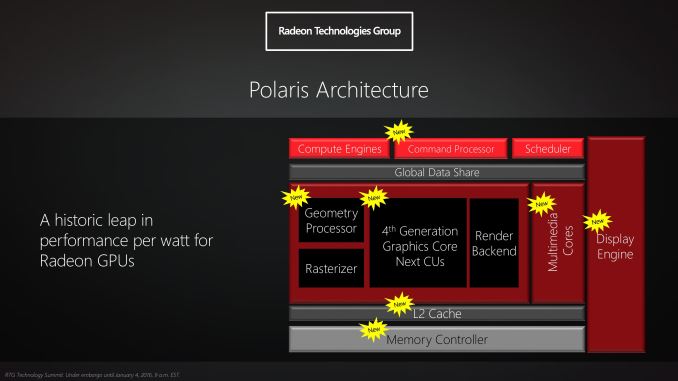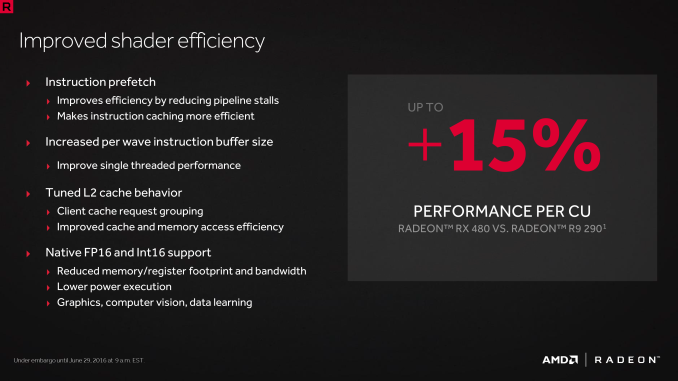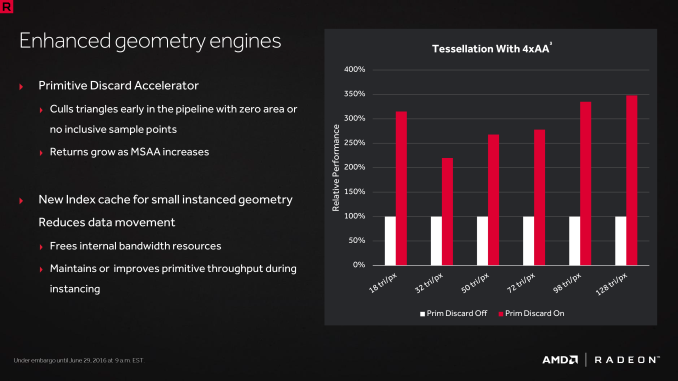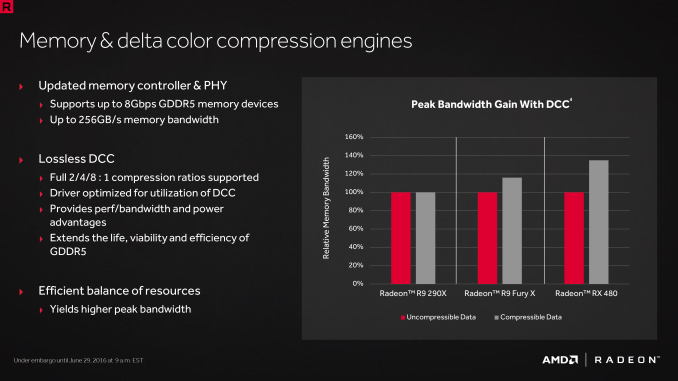The AMD Radeon RX 480 Preview: Polaris Makes Its Mainstream Mark
by Ryan Smith on June 29, 2016 9:00 AM ESTThe Polaris Architecture: In Brief
For today’s preview I’m going to quickly hit the highlights of the Polaris architecture.
In their announcement of the architecture this year, AMD laid out a basic overview of what components of the GPU would see major updates with Polaris. Polaris is not a complete overhaul of past AMD designs, but AMD has combined targeted performance upgrades with a chip-wide energy efficiency upgrade. As a result Polaris is a mix of old and new, and a lot more efficient in the process.
At its heart, Polaris is based on AMD’s 4th generation Graphics Core Next architecture (GCN 4). GCN 4 is not significantly different than GCN 1.2 (Tonga/Fiji), and in fact GCN 4’s ISA is identical to that of GCN 1.2’s. So everything we see here today comes not from broad, architectural changes, but from low-level microarchitectural changes that improve how instructions execute under the hood.
Overall AMD is claiming that GCN 4 (via RX 480) offers a 15% improvement in shader efficiency over GCN 1.1 (R9 290). This comes from two changes; instruction prefetching and a larger instruction buffer. In the case of the former, GCN 4 can, with the driver’s assistance, attempt to pre-fetch future instructions, something GCN 1.x could not do. When done correctly, this reduces/eliminates the need for a wave to stall to wait on an instruction fetch, keeping the CU fed and active more often. Meanwhile the per-wave instruction buffer (which is separate from the register file) has been increased from 12 DWORDs to 16 DWORDs, allowing more instructions to be buffered and, according to AMD, improving single-threaded performance.
Outside of the shader cores themselves, AMD has also made enhancements to the graphics front-end for Polaris. AMD’s latest architecture integrates what AMD calls a Primative Discard Accelerator. True to its name, the job of the discard accelerator is to remove (cull) triangles that are too small to be used, and to do so early enough in the rendering pipeline that the rest of the GPU is spared from having to deal with these unnecessary triangles. Degenerate triangles are culled before they even hit the vertex shader, while small triangles culled a bit later, after the vertex shader but before they hit the rasterizer. There’s no visual quality impact to this (only triangles that can’t be seen/rendered are culled), and as claimed by AMD, the benefits of the discard accelerator increase with MSAA levels, as MSAA otherwise exacerbates the small triangle problem.
Along these lines, Polaris also implements a new index cache, again meant to improve geometry performance. The index cache is designed specifically to accelerate geometry instancing performance, allowing small instanced geometry to stay close by in the cache, avoiding the power and bandwidth costs of shuffling this data around to other caches and VRAM.
Finally, at the back-end of the GPU, the ROP/L2/Memory controller partitions have also received their own updates. Chief among these is that Polaris implements the next generation of AMD’s delta color compression technology, which uses pattern matching to reduce the size and resulting memory bandwidth needs of frame buffers and render targets. As a result of this compression, color compression results in a de facto increase in available memory bandwidth and decrease in power consumption, at least so long as buffer is compressible. With Polaris, AMD supports a larger pattern library to better compress more buffers more often, improving on GCN 1.2 color compression by around 17%.
Otherwise we’ve already covered the increased L2 cache size, which is now at 2MB. Paired with this is AMD’s latest generation memory controller, which can now officially go to 8Gbps, and even a bit more than that when oveclocking.














449 Comments
View All Comments
Chris A. - Wednesday, June 29, 2016 - link
To replace my 7850 on my 1080p monitors maxed out at 60 Hz, it's an absolute winner.proxopspete - Wednesday, June 29, 2016 - link
That's where I am... just need a non-stock coolercatavalon21 - Wednesday, June 29, 2016 - link
I too have the 7850. I still would like to see some basic compute numbers for both, but yeah, this would handily fill the role for gaming...SunnyNW - Wednesday, June 29, 2016 - link
Others with 7850s...Did you notice that the FPS numbers for the 7850 seemed a little on the low side... Going back and testing I easily get around 30 fps at 1080p in the games where it was showing in the 20s. Does the choice of OS make a performance difference? Between Win 7/8/10?Laxaa - Thursday, June 30, 2016 - link
Same here. Now I'm debating if it's wise to go with the 8GB version, or if I should spring for the 4GB one and save money. I'll eventually get a 4K display, but that will mostly be because of work.HollyDOL - Wednesday, June 29, 2016 - link
eww, that's not really stellar, given the charts now GTX-1060 will likely have it for breakfast...D. Lister - Wednesday, June 29, 2016 - link
If I were Nvidia, at this point I would probably take half a 1070, factory-OC the bejeezus out of it, add 6GB gddr5, slap on a $150 MSRP and call it a day. :pChris A. - Wednesday, June 29, 2016 - link
Remember that die size on the 1070 is 40-50% larger than the RX480, so their margin is going to be smaller to reach that price point.Yojimbo - Thursday, June 30, 2016 - link
Yeah there's no reason to use GP104 when they have GP106 for that purpose.Ananke - Wednesday, June 29, 2016 - link
NVidia has never in its history "slapped" $150 when they can put $300 price tag. At best, whenever such thing as GTX1050 happen, it may be around $200 mark for half of this performance. NVidia will never cannibalize its prices, they sell their 1070/1080 with markup easily anyway. There is no reason for them to not have markup on 1060/1050 as well.